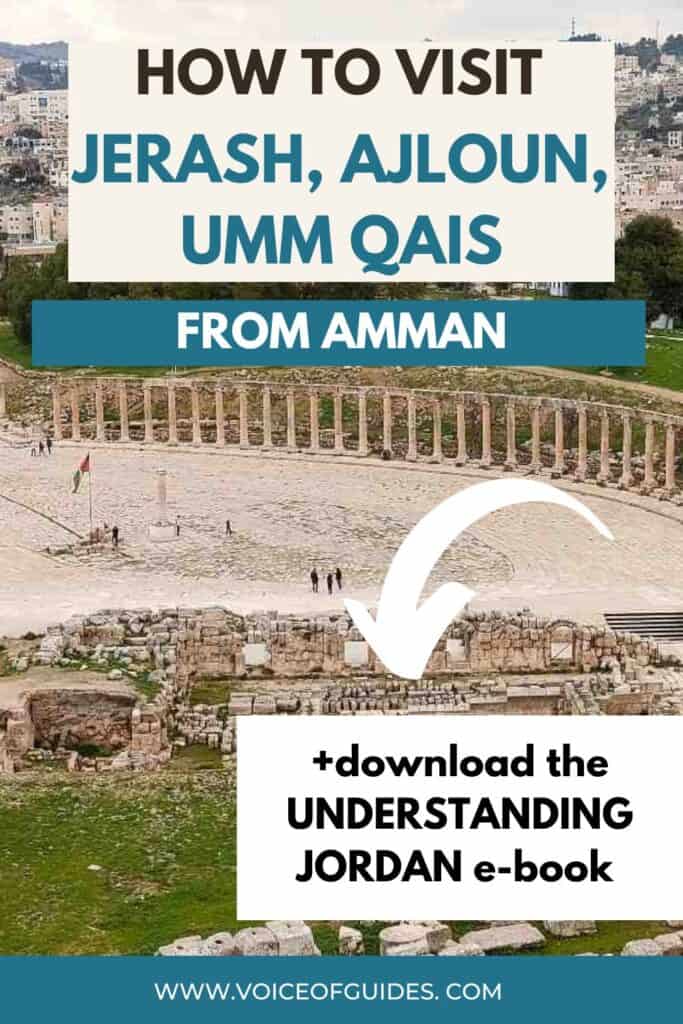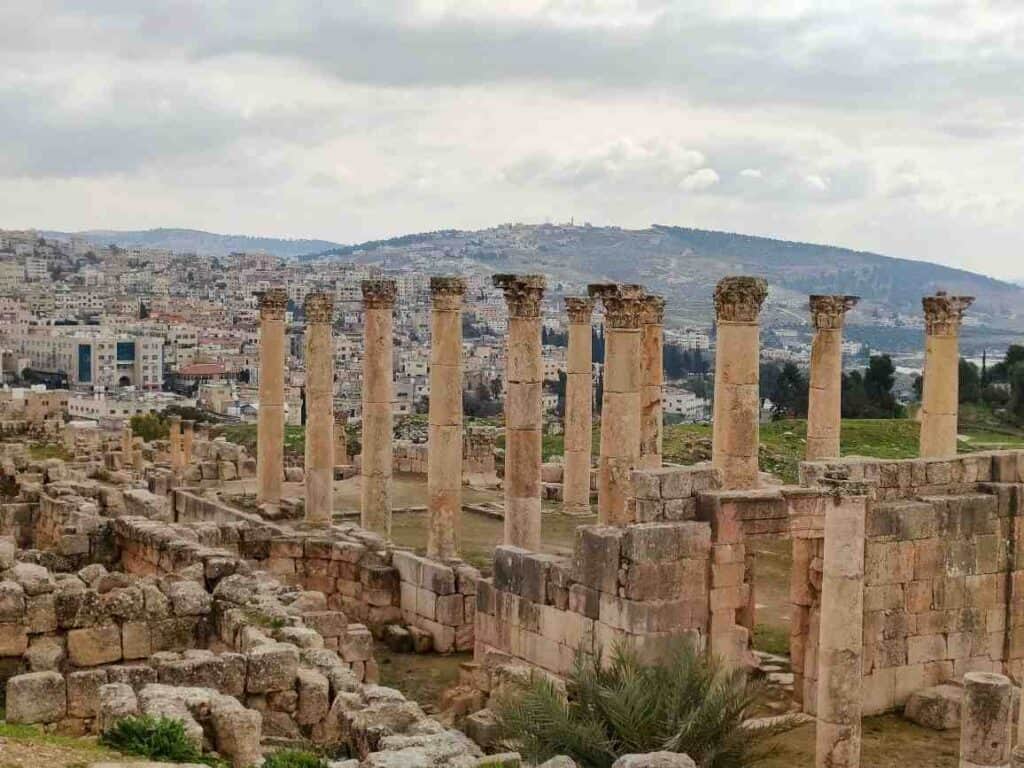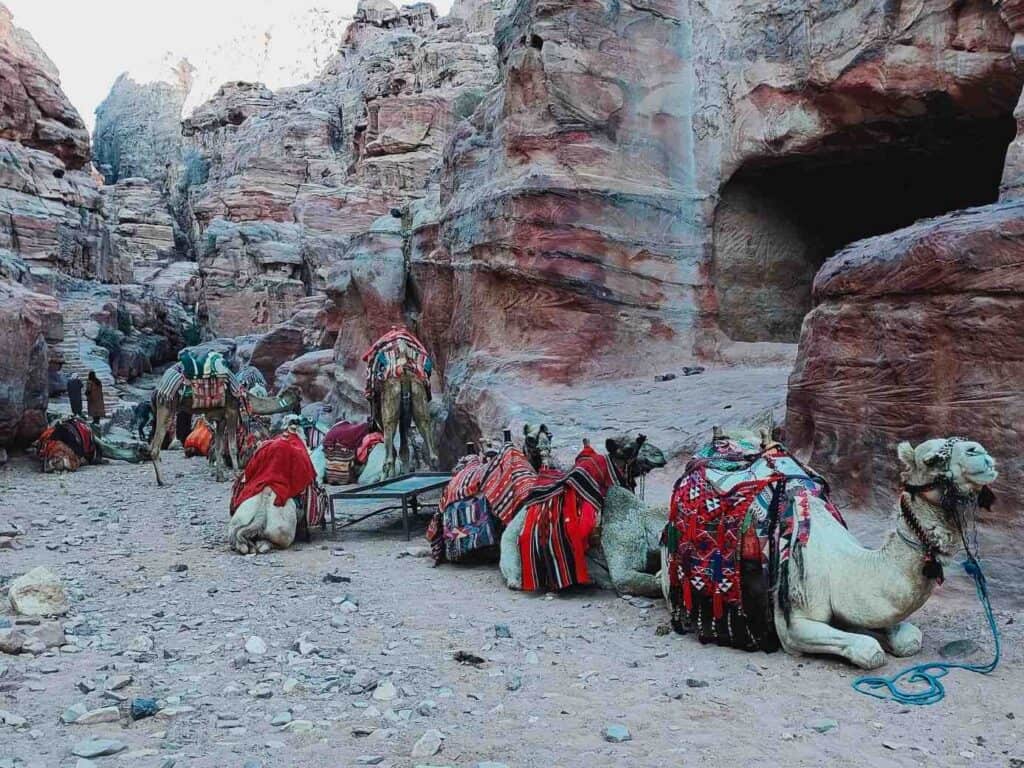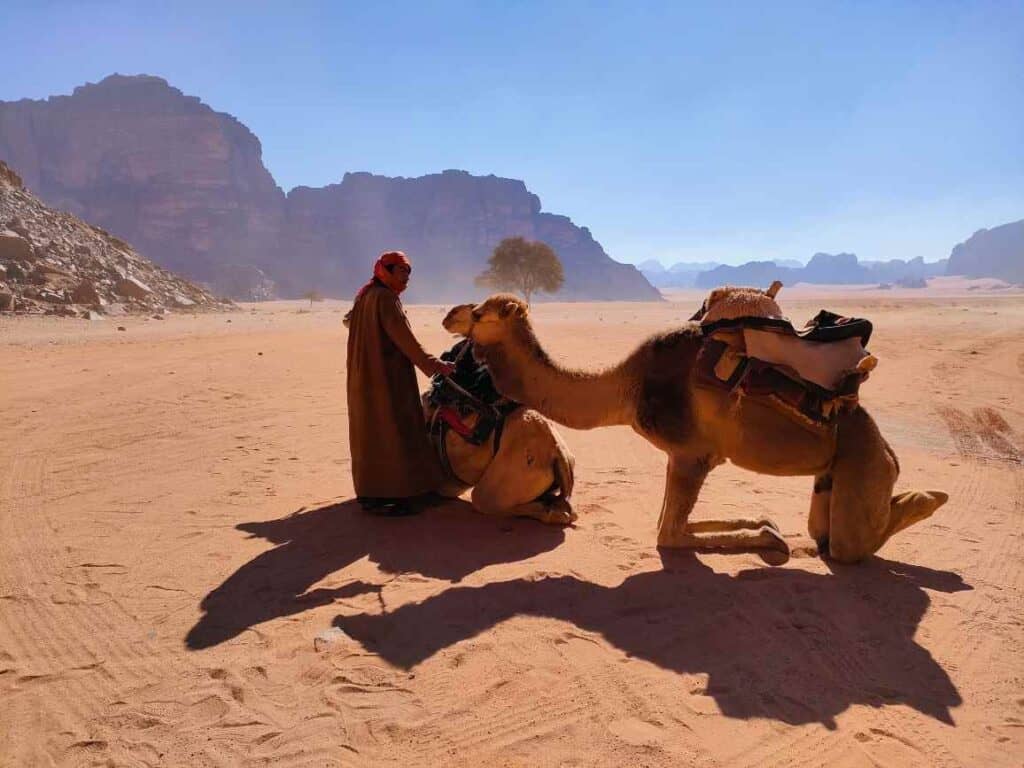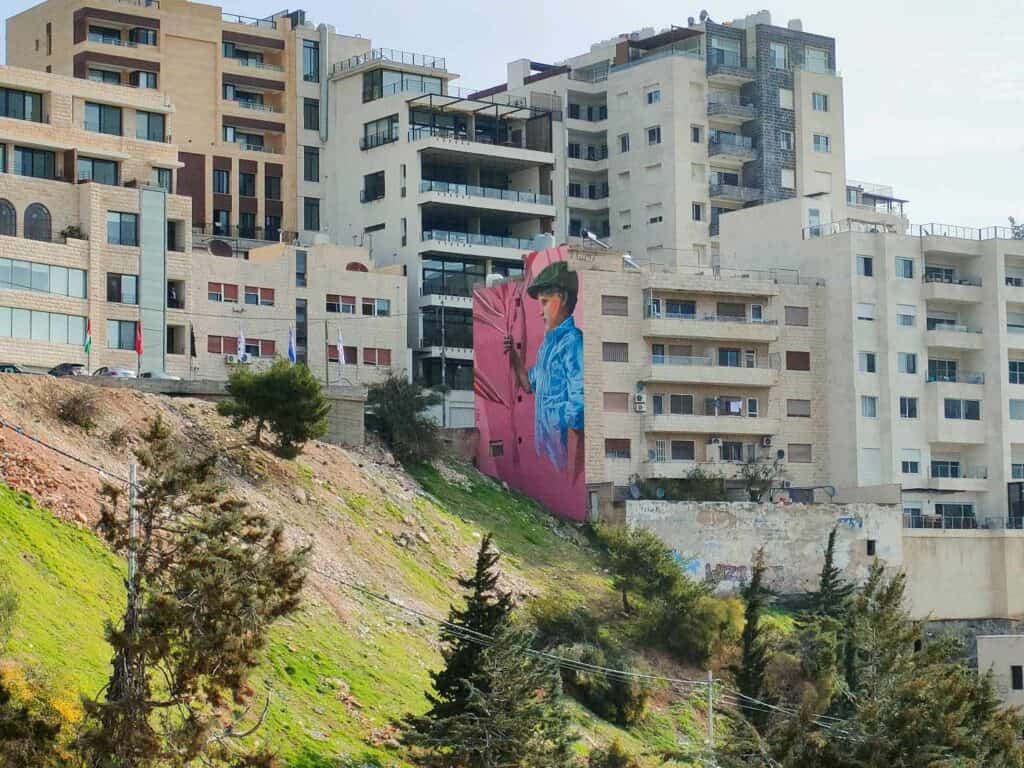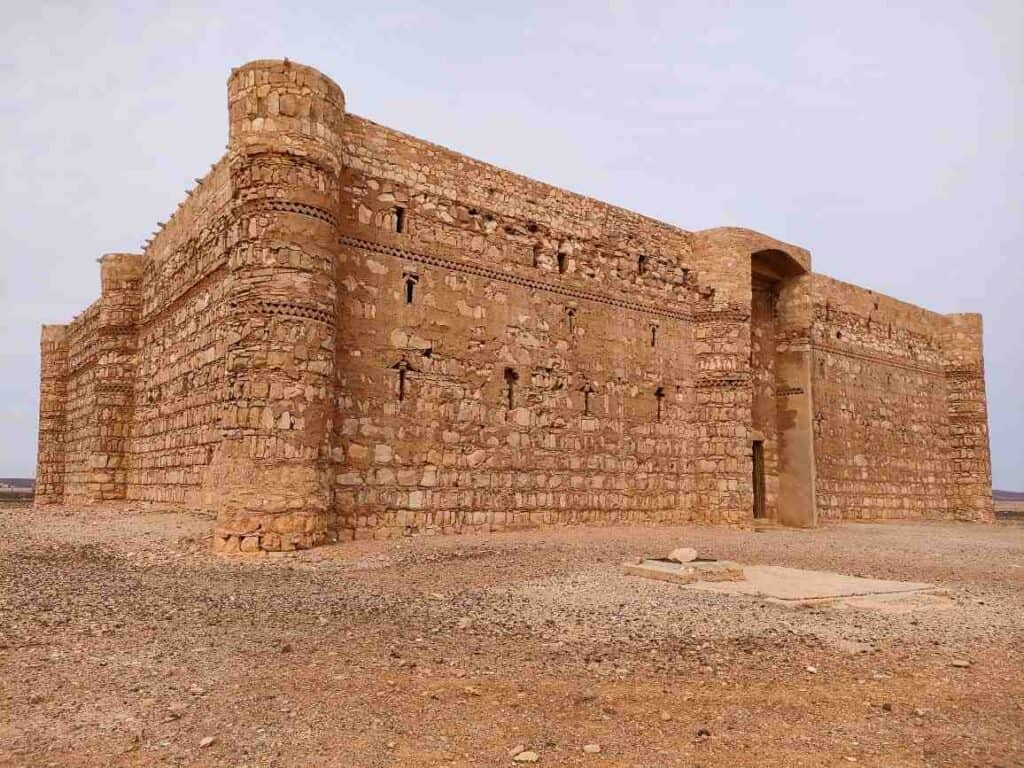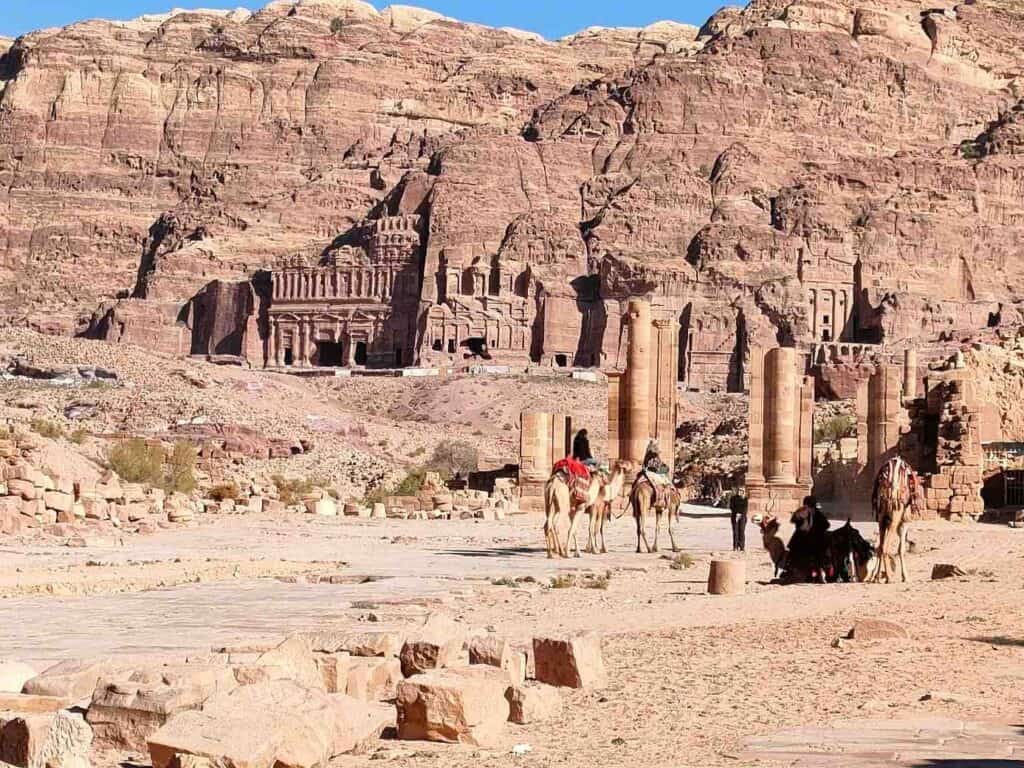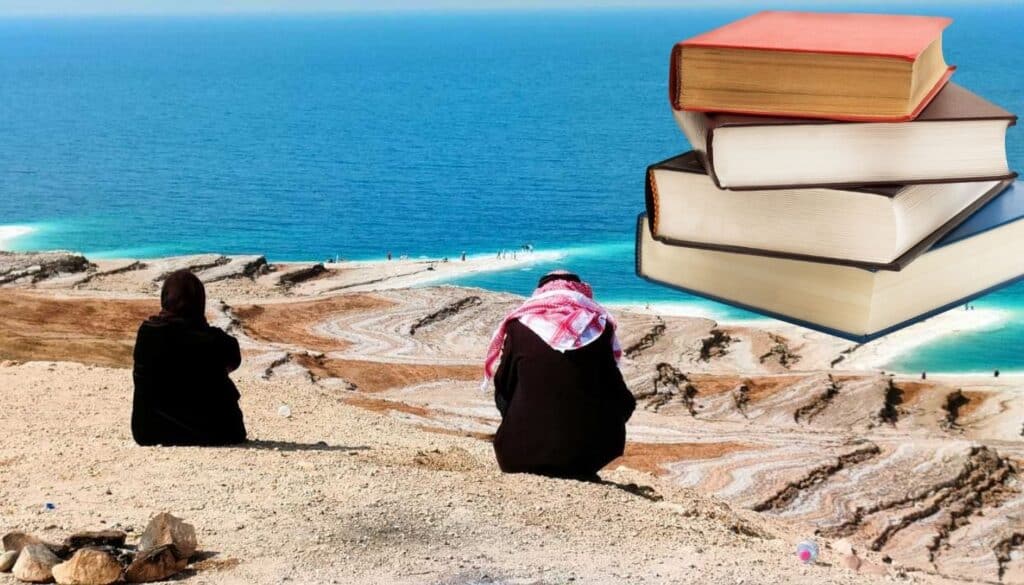This article may contain affiliate / compensated links. For full information, please see our disclaimer here.
Traveling to the north from the Jordanian capital to see the Roman ruins of Jerash, the castle of Ajloun, and Umm Qais is one of the best day trips from Amman. You can cover Jerash and Ajloun with public transport if you don’t have a car. If you have a car or do a private tour, you can cover all three sights in one-day. This travel guide gives you all the information about the day trip from Amman to Jerash, Ajloun and Umm Qais.
- How to go from Amman to Jerash?
- Opening hours of Jerash, Ajloun and Umm Qais
- Entrance fee to Jerash, Ajloun and Umm Qais
- What you should know about Jerash
- Things to see in Jerash
- Where to sleep in Jerash?
- How to go from Jerash to Ajloun?
- Is it worth visiting Umm Qais (Gadara)?
- The ruins of Umm Qais (Gadara)
- The view of Umm Qais
- Other articles about Jordan
- Other posts about the Middle East
- Pin it for later!
- Other posts about Jordan
Before you continue read this post about the best 5, 7 and 10 day Jordan itinerary
How to go from Amman to Jerash?
With public transport:
Public buses and minibuses regularly leave for Jerash from the North Bus Station (Tabarbour) in Amman (800 fils, 1¼ hours). Expect to wait even an hour sometimes until it gets full. But if you are lucky, you may not need to wait too much.
When you arrive in Jerash, you have a 10 minutes’ walk to the entrance of the Jerash archeological site.
With private taxi:
A private taxi between Amman and Jerash costs around 20 JOD.
Check the private tours to Jerash, Ajloun and Umm Qais
Opening hours of Jerash, Ajloun and Umm Qais
You can find all the opening hours here:
https://www.jordanpass.jo/contents/Opening_Hours.aspx
Entrance fee to Jerash, Ajloun and Umm Qais
Entrance fee to Jerash: included in the Jordan pass or 12 JOD
Entrance fee to Ajloun castle: included in the Jordan Pass or 3 JOD
Entrance fee to Umm Qais: included in the Jordan Pass or 3 JOD
What you should know about Jerash
Jerash lies 50 kilometers north of Amman, close to the fertile Jordan valley. Gerasa, as it was called during Roman times, became a prosperous city along one of the most ancient trade routes in the world. The Nabateans supervised the passing trade of spices, Indian silk, African ivory, etc., from Petra.
When Emperor Trajan annexed the wealthy Nabatean Kingdom and founded the Province of Arabia, he connected Damascus and Philadaelphia (current Amman) via road and erected several new buildings with marble and granite decoration.
Jerash lived its golden age in the 2nd century when the stunning Artemis and Zeus temples were built. The Arch of Hadrian was constructed to honor the emperor’s visit to Gerasa, where people welcomed him with festive celebrations. This boosted construction in Gerasa, with already 20 000 inhabitants at that time. However, people did not live in the center but the suburbs in separate residential quarters.
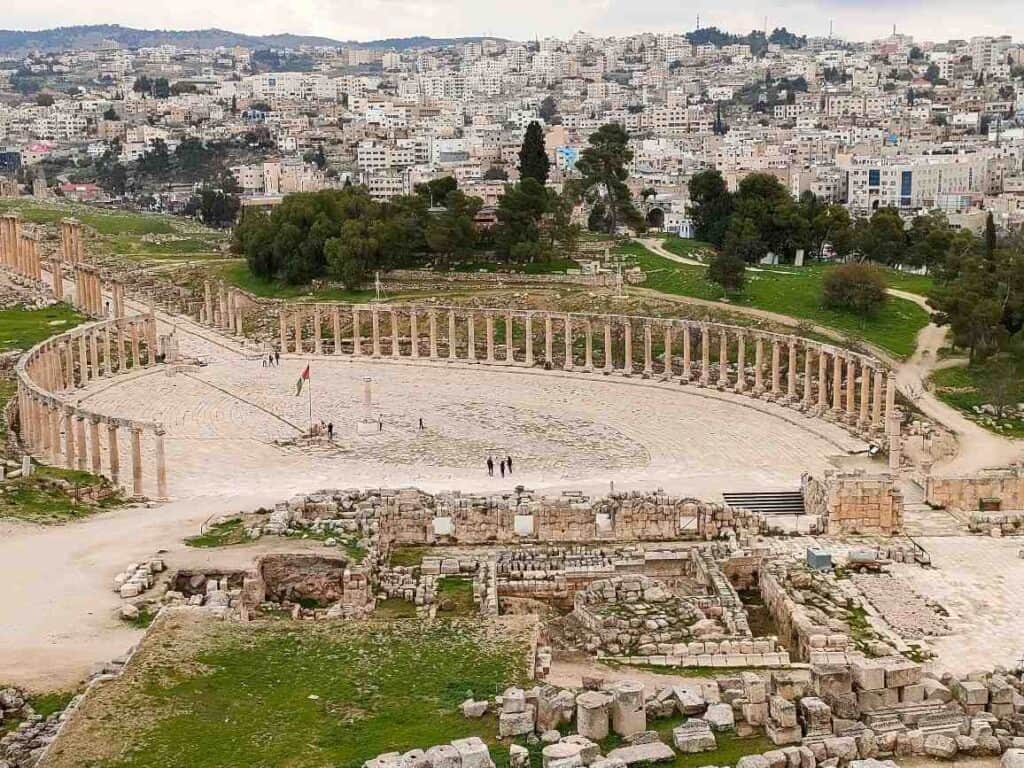
The golden age of Jordan ended after Roman rule. As usual, when trade routes moved to the sea in the 3rd century, Jerash degraded to an insignificant settlement. The earthquake in the 8th century led to its final collapse. Its glorious Roman name, Gerasa, was changed to the current Arabic name, Jerash and soon the ancient ruins got covered with sand and entirely forgotten.
Life returned to Jerash in the 19th century when the Circassians from Central Asia settled down and built their town outside the Roman ruins in today’s Jerash.
Ulrich Jasper Seetzen, a German traveler, discovered the ruins of Gerasa in 1806, but large-scale excavations only started in the 1920s. What you see now is still only approximately 30% of ancient Jerash.
Modern Jerash is home to the Gaza Camp with Palestinians from the Gaza stripe. In general, Jordan is a country of refugees. Over 60% of the total population of 10 million are Palestinians, most of whom are considered Jordanians. King Hussein (1952-1999) offered citizenship to all who arrived after the first Arab-Israeli war of 1947-48 and the 6-day war of 1967. The population tripled in a short time. Some refused to become Jordanian citizens because that would deprive them of the opportunity to return to Palestine.
However, the situation of refugees from Gaza remains unresolved. When Jordan offered citizenship to the refugees, it applied only to those who lived in the West Bank and East Jerusalem under Jordan’s rule at that time. Since Gaza was under Egyptian control after the first Arab-Israeli war until the 6-day war, those living in the Gaza Strip were not offered Jordanian citizenship.
Their situation has been unsettled ever since. They do not have Jordanian citizenship or the right to vote, and it is complicated for them to buy real estate and find work. They do not have the right to state aid and face rejection when approaching a local woman. If the situation does not change, the same fate awaits their children. After more than 50 years, they are the only Palestinian refugees who were not granted citizenship.
How to plan your trip to Jordan?
Flights: find the best flight deals on Skyscanner
Rent a car: Check Discover Cars‘ deals for driving around in Jordan (the best way to discover the country)
Insurance: Safetywing is a cheap insurance that covers all medical issues, including COVID-related ones. This is what I use every time.
Hotel/Hostel: Booking.com
Local tours and guides in Jordan: Toursbylocals, GetYourGuide and Viator offer several customized tours to Petra
Things to see in Jerash
Arch of Hadrian
The impressive Arch was built upon his arrival in 129 and was twice as big as now as it was supposed to be the city’s main entrance. However, in the end, the surrounding walls were never built. So, the Arch stands now alone, 450 meters from the walls.
Hippodrome
The hippodrome (stadium for horse and chariot racing) could host 15 000 people, making it the largest monument in Jerash. Watching sports events and other races was people’s favorite entertainment at that time.
In 2005, after 1500 years, they revived the ancient tradition and organized a chariot race again in the hippodrome.
The South Gate
People from Amman approached the city through this gate with a similar decoration to the Arch of Hadrian. It was part of the 3.5 km long and 3 meters thick city walls.
Oval plaza
The oval-shaped square surrounded by 160 ionic columns, is one of Jerash’s best-preserved parts, the people’s primary meeting point. Some say this square connected the Temple of Zeus with the principal Cardo Maximus road. The outer circles are made of bigger stones than the inner circles to emphasize the oval shape.
Cardo Maximus
The most important public buildings opened to this 800-meter-long principal route built in the 1st century. There were 500 columns along the Cardo Maximus of different heights adjusting to the size of buildings behind. An aqueduct above the colonnade led the water to the houses. The original iconic columns were replaced with Corinthian ones that still stand today. Fountains and shops occupied the space under the arcades. The canal system under the road collected and drained the rain and used water. The pavement is entirely original, and you can notice the chariots’ traces in many places.
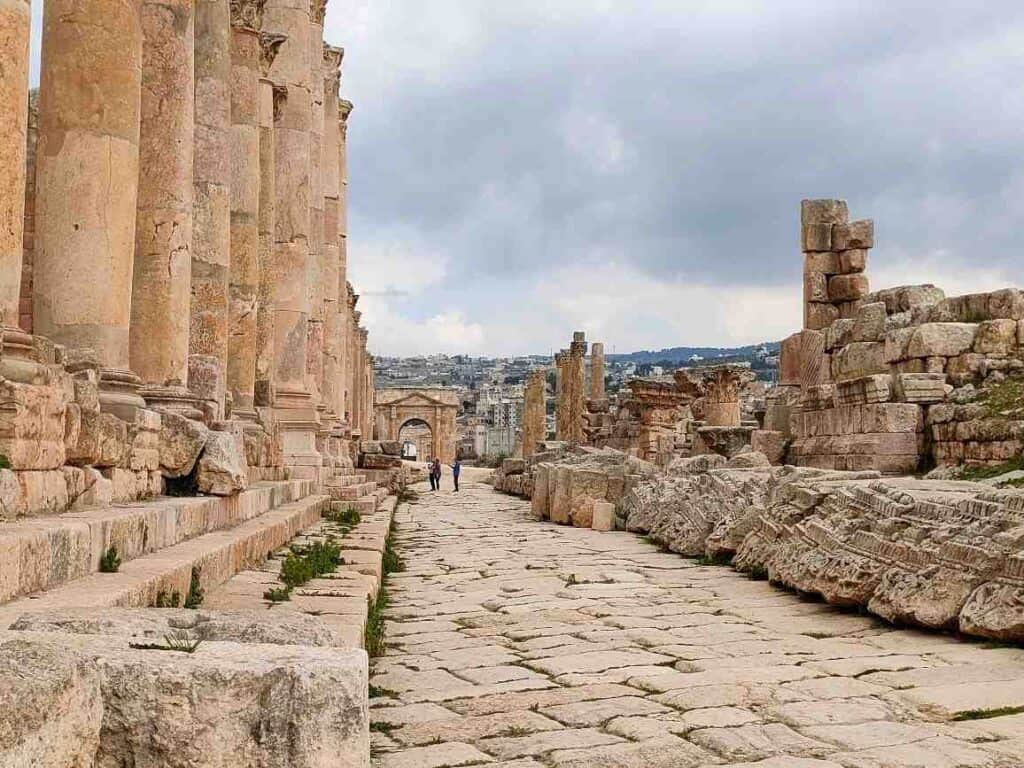
Temple of Zeus
The temple of Zeus is one of the most important monuments of Jerash that you can reach through the stairs from the oval plaza. The temple gained its final form during Emperor Hadrian by extending a former Roman temple. During the Byzantine times, it was used as a Christian temple. The central courtyard served to offer sacrifice to the god.
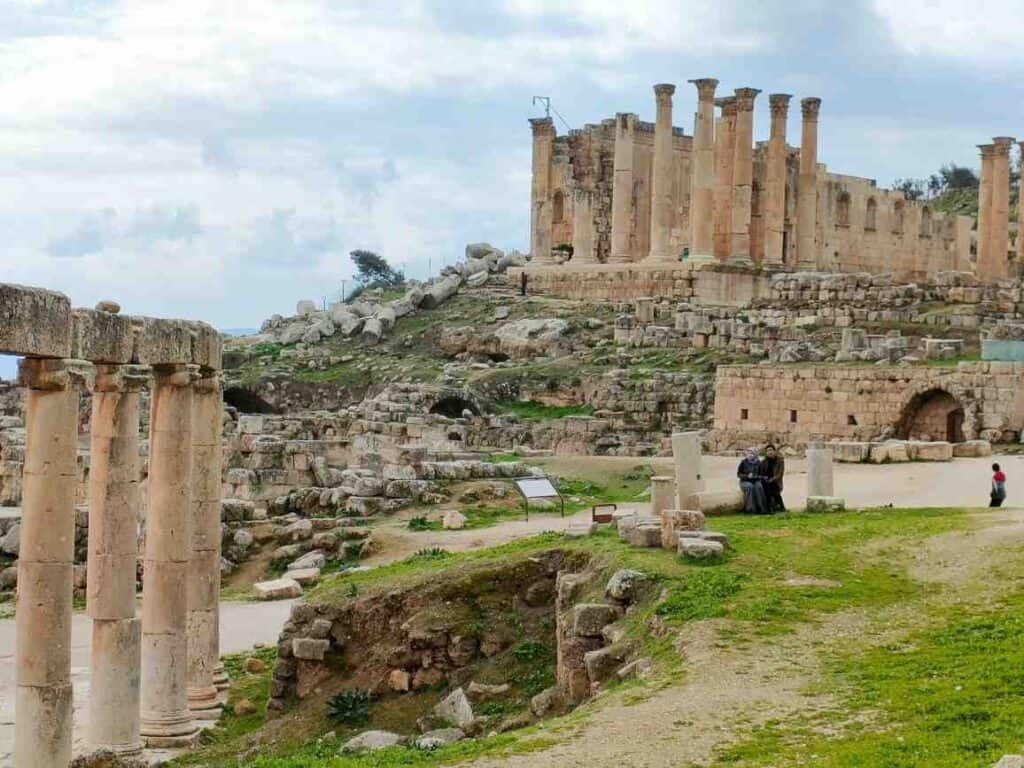
Southern theater
This was the biggest theater in Gerasa. The stone seats indicated the places, and pieces of clay served as entrance tickets. The theater could accommodate 5000 people and could be transformed into artificial pools to create sea fights. It was constructed with a perfect acoustic that you can experience during the famous annual Jerash festival.
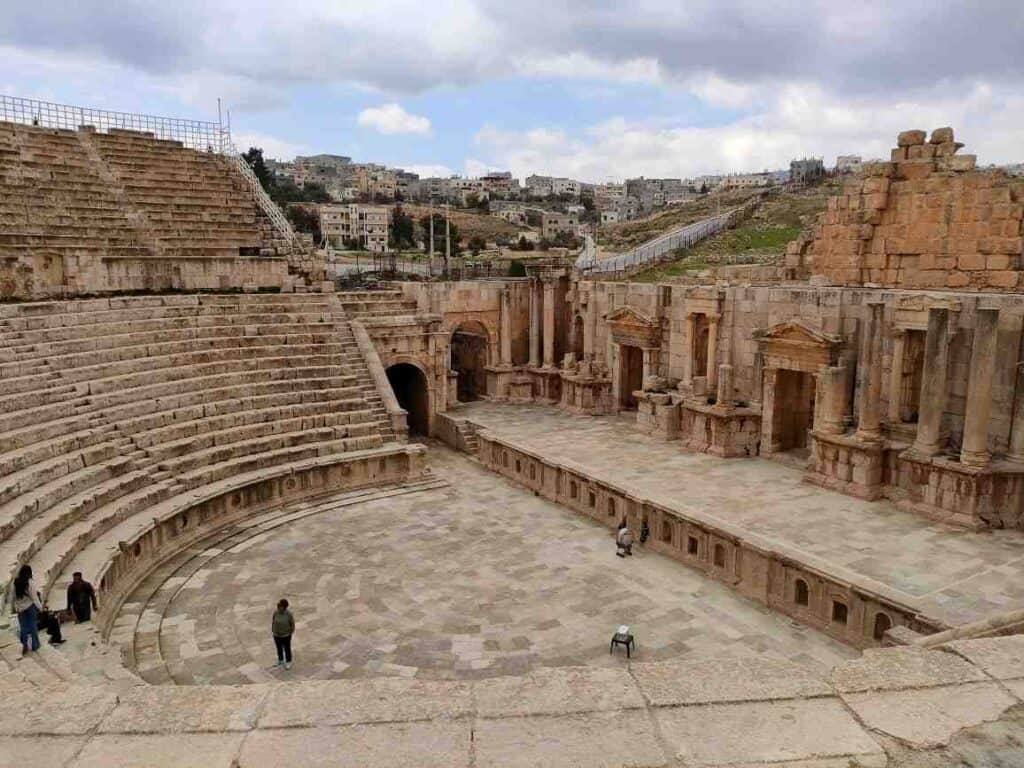
Nymphaeum
Like in Amman, a nicely decorated fountain was a popular meeting place for ordinary people.
Cathedral
Next to the Cardo Maximus stands the Byzantine church from the 4th century. The ruins of Dushara’s shrine (Nabatean god) were discovered under the cathedral.
North Gate
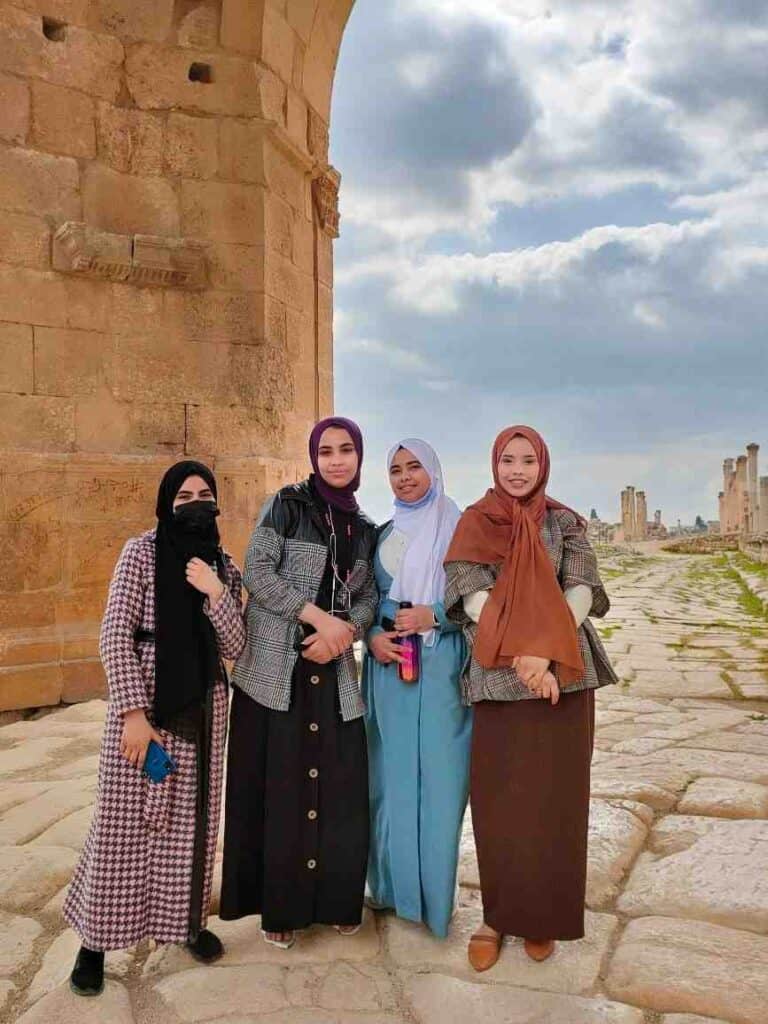
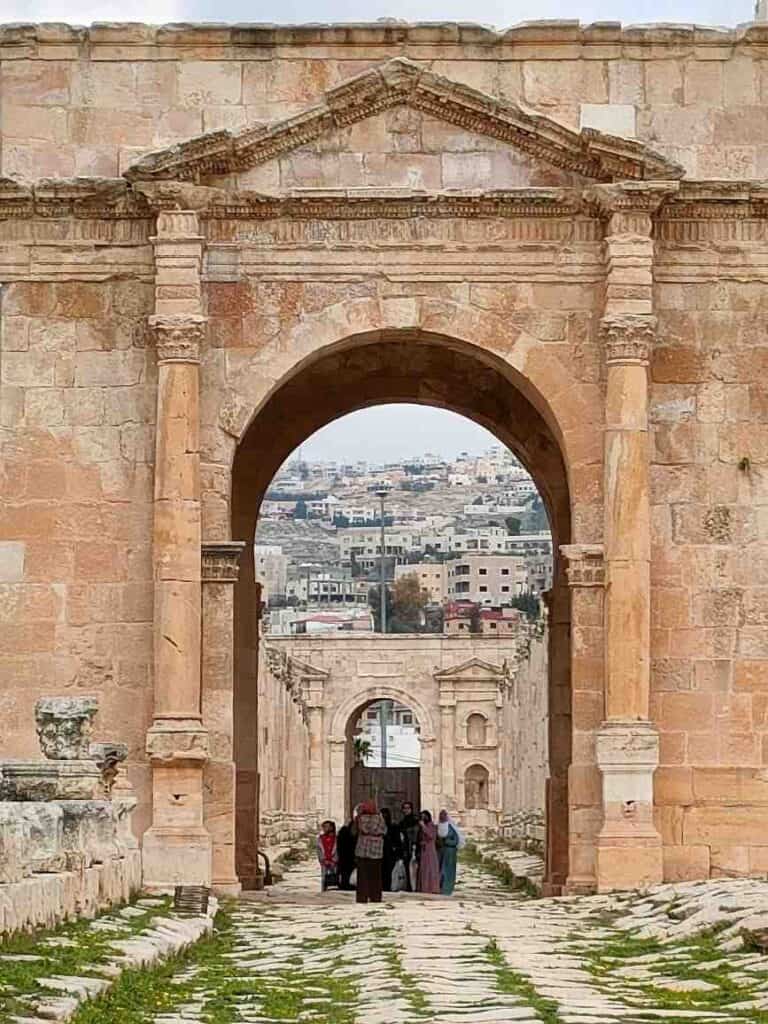
Temple of Artemis
The Temple of Artemis, dedicated to the daughter of Zeus and the brother of Apollo, is probably the most beautiful thing to see in Jerash with 100-meter-long stair leads to the temple’s entrance. Artemis was also the protecting deity of Gerasa. Interestingly, some of the columns are moving, especially in windy weather. Locals are ready to show you by placing a small coin into the holes. They also guide you to the best photo posts and take perfect pictures of you for some tips.
The 11 Corinthian columns are the most beautiful part of the temple, which dates back to the 2nd century. Imagine the statues of Artemis in the niches and the marble cover of the temple in its golden ages.
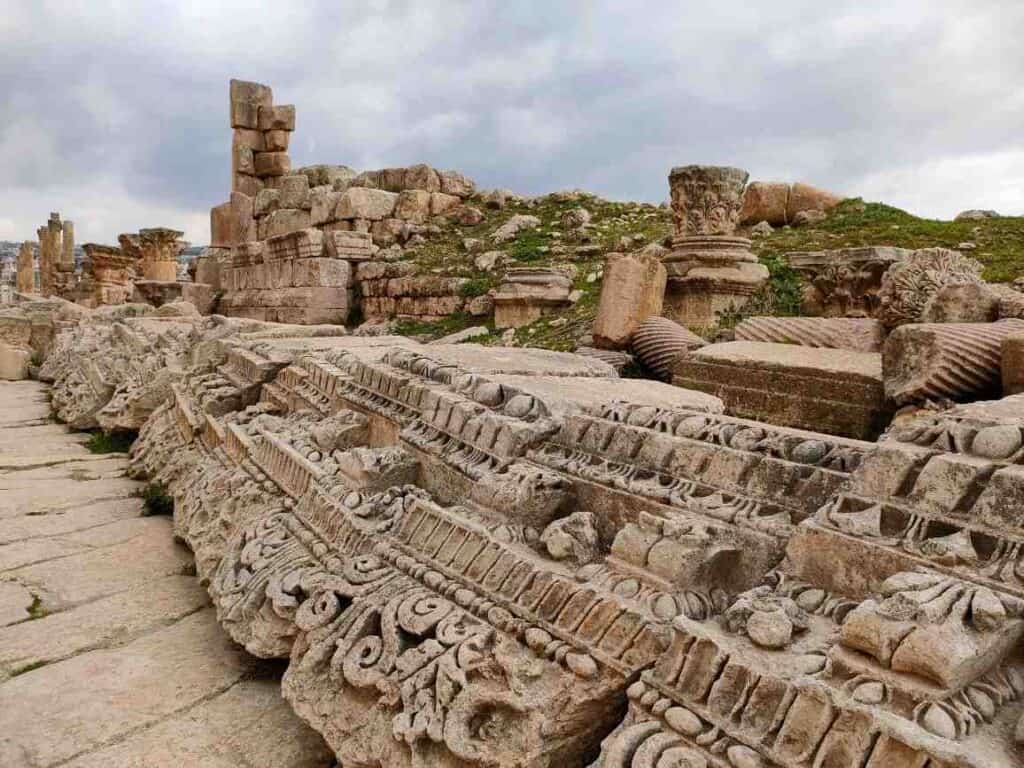
Northern theater
The city council’s leaders probably gathered in the northern theater that was the home of music and poetry until the 5th and 6th centuries.
The Macellum (market) and bathes are other things to see in Jerash.
Where to sleep in Jerash?
Recommended places to stay in Jerash for the night instead of making it a day trip from Amman:
Full Panorama to Archeological Site Jerash
The Blue House (Gerasa) – hostel
How to go from Jerash to Ajloun?
At the crossing near the Roman ruins of Jerash (the same place where you arrived from Amman), you can catch a minibus to continue further to the north to Ajloun. The 30 minutes ride cost 0.5 JOD.
How to return from Ajloun to Amman?
The last minibus departs at 4 pm (or when it gets full) from Ajloun to Amman. If you miss that, you can only get a private taxi back to the capital.
Things to do in Ajloun
Visiting the Qal’at ar-Rabad fortress, with a stunning location perched on a hilltop, is the best thing to do in Ajloun. The Islamic-style military fort was built in the 12th century and enlarged by the Mamluks of Egypt in the 13th.
Being a perfect place to control the Jordan valley, it was an important element of the defense system against the Crusaders, whose fortress stood at the nearby lake of Galilee. It was also one of a series of watchtowers and pigeon stations used to forward messages between Damascus and Cairo in a single day.
The castle was rediscovered by a famous western traveler, Johann Ludwig Burckhardt, who came across it on his way to Petra.
You can get to the castle from the city center by car, a couple of kilometers away.
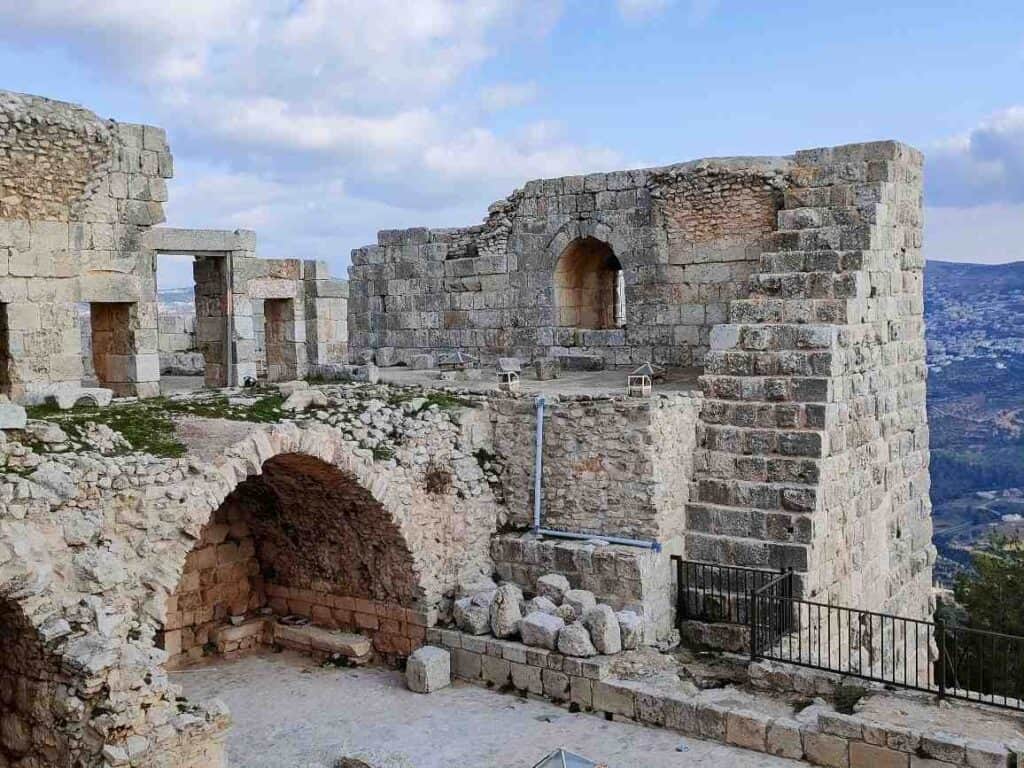
Is it worth visiting Umm Qais (Gadara)?
Fewer tourists head to the very north of Jordan, where the ruins of Umm Qais, another city of the Decapolis, are located close to the border with Syria and Israel. The landscape itself is worth the drive up there, with expansive green pastures and flowers that contrast the overwhelmingly deserted other parts of Jordan. During the summer heat, visiting Umm Qais is a real refreshment. So yes, it is definitely worth it!
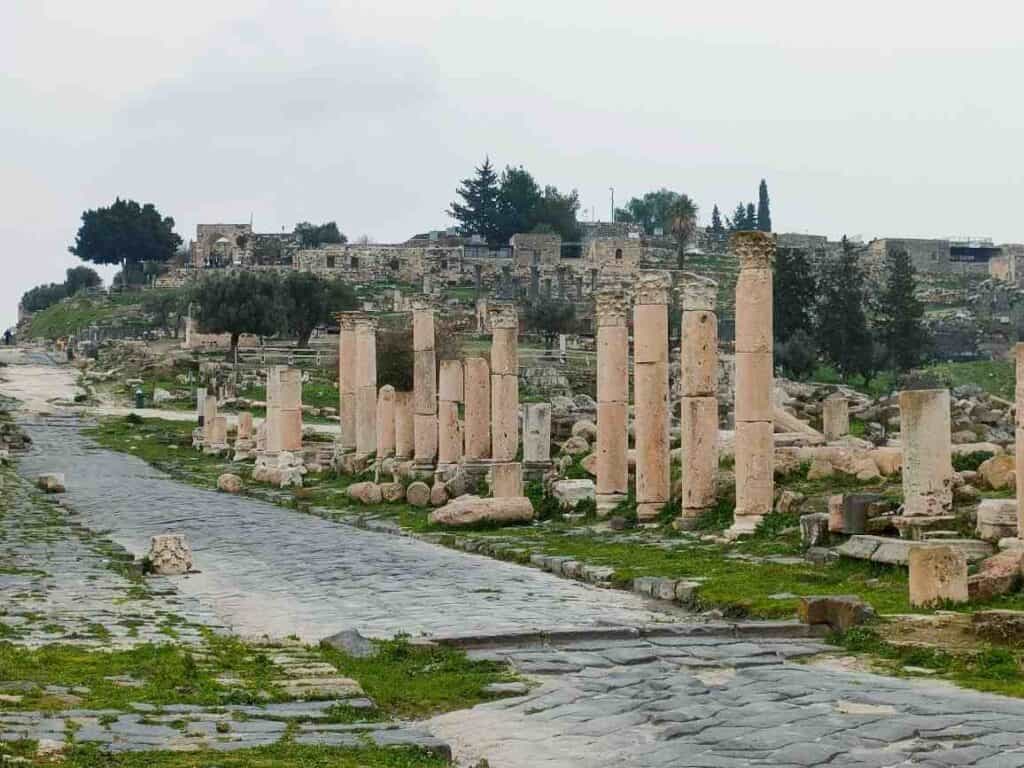
According to the Bible, Jesus cast out the devils from the two possessed people in Gadara and sent the demons into a herd of pigs. In the story, Gadara became a place of pilgrimage in the early Christian era, although another village on the other side of Lake Galilee on the Israeli side also claims the miracle.
You can only cover Umm Qais on a day trip from Amman after Jerash and Ajloun on a private tour or if you have a rented car. Don’t forget your passport to show at the numerous police checkpoints.
Book your local tour to Jerash, Ajloun and Umm Qais
Apart from the ruins of Umm Qais, Al-Himma is a popular bathing place nearby, right next to the Israeli-occupied Golan Heights. Don’t expect anything extraordinary. It is for those looking for a nice hot bath and an authentic local experience. In this case, you should stay for the night in Umm Qais. There is a checkpoint between Umm Qais and al Himma (20 minutes’ drive), where they ask where you are going and ask to show your passport.
The ruins of Umm Qais (Gadara)
Large-scale constructions were carried out under the Romans. Octavian donated his army to Herod, and the city remained in the hands of the Jews until Herod’s death (4 BC). After that Gadara regained its autonomy as part of the province of Syria. The fall of the Nabatean kingdom in 106 increased its importance. During the early Christian era, it was the bishop’s seat, but during the Muslim conquest of the 7th century, it was considered only a small village. Later, the Ottomans completely rebuilt the village.
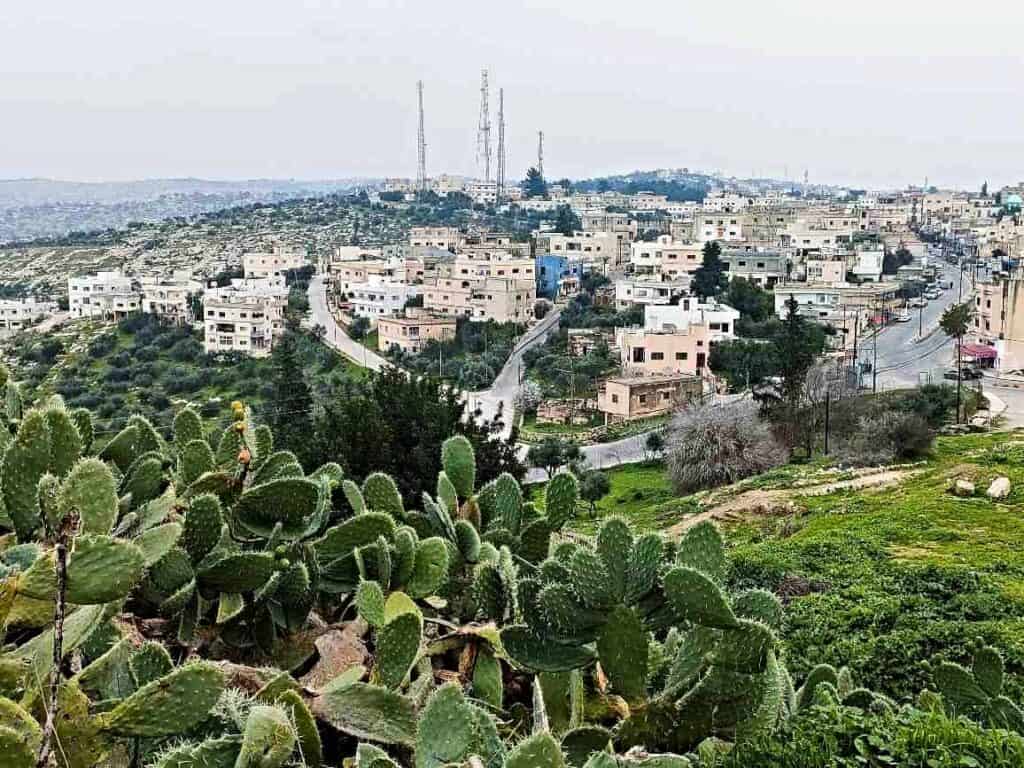
A Western traveler discovered the ancient ruins of Umm Qais in 1806.
This is where the first Jordanian government was established, and the first official treaty with the British was signed in 1920. Archaeological excavations began in the 1980s after the villagers had been relocated to the neighboring Umm Qais.
Some of the main parts of the Roman ruins of Umm Qais are the North and West Theatre made of black basalt. Similar to the theater in Jerash, it was built with extraordinary acoustics.
The Decumanus Maximus, the principal road of the Roman site, linked Gadara with other settlements, such as Pella or Abila. It even extended to the Mediterranean Sea.
Public baths, Roman tombs are places of interest in Jerash.
The view of Umm Qais
The ruins of Jerash are more impressive, but what is unique about Umm Qais is that from one point (indicated on the map inside the archeological site), you can see the Jordan valley, Lebanon, Syria, Israel and the Palestinian Territories at the same time. (Mount Hermon, Damascus, Tiberias Lake, Nazareth, Golan Heights and Beirut).
The Jordan valley is the food bowl of Jordan. Since 1948 the Jordan River has marked the boundary between Jordan and Israel and the Palestinian Territories, from the Sea of Galilee to the Yarmouk River, the largest tributary of the Jordan river. Christians revere the Jordan River because Jesus was baptized in its waters by John the Baptist at the site of Bethany. During the 1967 war with Israel, Jordan lost the West Bank, and the population on the Jordanian East Bank dropped from 60,000 before the war to 5000 by 1971. During the 1970s, new roads and fully serviced villages were built, and the population has now soared to more than 100,000.

Having a day trip from Amman to Jerash, Ajloun and if you have a car to Umm Qais is one of the best day trips from the capital. The north of Jordan has an entirely different landscape with green hills covered with flowers. Plus, it is unique to see the Jordan valley, Israel and Syria from a particular spot in Umm Qais. If you spend at least 7 days in Jordan, you should include it as a day trip from Amman.
Other articles about Jordan
The perfect Petra one and two-day itinerary in Petra
Visiting Jerash, Ajloun and Umm Qais
Jordan desert castles: a day trip from Amman
5, 7 and 10 day Jordan travel itineraries
All you need to know before traveling to Jordan
Other posts about the Middle East
Lebanon
10-day itinerary to visit Lebanon
How to spend 2-3 days in Beirut
Travel guide to Tripoli, Lebanon
Best books to read about Lebanon
Traveling around Lebanon during the economic crisis
Iran
What you can and cannot do in Iran
45 things you must know before traveling to Iran
The best books to read about Iran
The best 2-week itinerary in Iran (the classical route)
All you need to know about the Iranian currency
The best places to visit in Tehran (museums, palaces, religious sites)
The best things to do in Tehran
Travel guide to Tabriz, North Iran
Travel guide to Mashhad, the holy city of Iran
Best things to do in Lahijan, the city of tea in Iran
Best things to do in Ramsar at the Caspian Sea
Visit Varzaneh desert, Toudeshk, Mesr desert and Garmeh from Isfahan
Iraq
All you need to know before traveling to Iraq
What to visit in Baghdad in 3-4 days
The best books to read about Iraq (constantly updated)
Visiting Lalish, the holy place of Yezidi people
How to visit Babylon and other places around Hillah
Most interesting places to visit in Iraq
Pin it for later!
